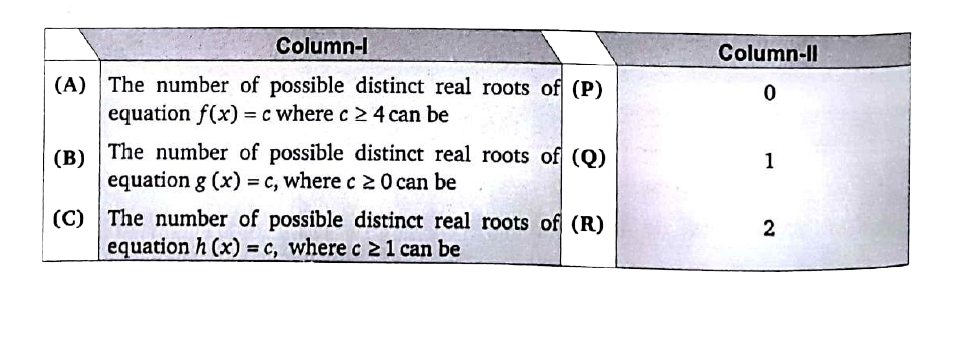Suppose a∈R. Define f and g as follows:
f(x)=(a2−4a+3)x2+(a2−1)a∀x∈R and g(x)=(a2−5a+6)x3+(a2−3a+2)x+(a3−1)∀x∈R
The number of values of a for which f(x)=g(x)∀x∈R
0
1
2
infinite
The correct Answer is:B
To solve the problem, we need to find the number of values of a for which the functions f(x) and g(x) are equal for all x∈R.
Step 1: Write down the functions
The functions are defined as:
f(x)=(a2−4a+3)x2+(a2−1)a
g(x)=(a2−5a+6)x3+(a2−3a+2)x+(a3−1)
Step 2: Set the functions equal to each other
We need to set f(x)=g(x):
(a2−4a+3)x2+(a2−1)a=(a2−5a+6)x3+(a2−3a+2)x+(a3−1)
Step 3: Rearranging the equation
Rearranging gives us:
0=(a2−5a+6)x3+(a2−3a+2)x+(a3−1)−(a2−4a+3)x2−(a2−1)a
Step 4: Group terms by powers of x
Now we will group the terms by the powers of x:
- Coefficient of x3: a2−5a+6
- Coefficient of x2: −(a2−4a+3)
- Coefficient of x: a2−3a+2
- Constant term: a3−1−(a2−1)a
Step 5: Set coefficients equal to zero
For f(x) and g(x) to be equal for all x, each coefficient must be equal to zero:
1. a2−5a+6=0
2. −(a2−4a+3)=0
3. a2−3a+2=0
4. a3−1−(a2−1)a=0
Step 6: Solve each equation
1. From a2−5a+6=0:
(a−2)(a−3)=0⟹a=2 or a=3
2. From −(a2−4a+3)=0:
a2−4a+3=0⟹(a−1)(a−3)=0⟹a=1 or a=3
3. From a2−3a+2=0:
(a−1)(a−2)=0⟹a=1 or a=2
4. From a3−1−(a2−1)a=0:
a3−1−a3+a=0⟹a−1=0⟹a=1
Step 7: Combine solutions
The possible values of a from all equations are:
- From the first equation: 2,3
- From the second equation: 1,3
- From the third equation: 1,2
- From the fourth equation: 1
The unique values of a that satisfy all equations are 1,2,3.
Conclusion
Thus, the number of values of a for which f(x)=g(x) for all x∈R is 3.
---
The functions are defined as:
f(x)=(a2−4a+3)x2+(a2−1)a
g(x)=(a2−5a+6)x3+(a2−3a+2)x+(a3−1)
We need to set f(x)=g(x):
(a2−4a+3)x2+(a2−1)a=(a2−5a+6)x3+(a2−3a+2)x+(a3−1)
Rearranging gives us:
0=(a2−5a+6)x3+(a2−3a+2)x+(a3−1)−(a2−4a+3)x2−(a2−1)a
Now we will group the terms by the powers of x:
- Coefficient of x3: a2−5a+6
- Coefficient of x2: −(a2−4a+3)
- Coefficient of x: a2−3a+2
- Constant term: a3−1−(a2−1)a
For f(x) and g(x) to be equal for all x, each coefficient must be equal to zero:
1. a2−5a+6=0
2. −(a2−4a+3)=0
3. a2−3a+2=0
4. a3−1−(a2−1)a=0
1. From a2−5a+6=0:
(a−2)(a−3)=0⟹a=2 or a=3
a2−4a+3=0⟹(a−1)(a−3)=0⟹a=1 or a=3
(a−1)(a−2)=0⟹a=1 or a=2
a3−1−a3+a=0⟹a−1=0⟹a=1
The possible values of a from all equations are:
- From the first equation: 2,3
- From the second equation: 1,3
- From the third equation: 1,2
- From the fourth equation: 1
Thus, the number of values of a for which f(x)=g(x) for all x∈R is 3.
Topper's Solved these Questions
- SETS, RELATIONS AND FUNCTIONSBOOK - MCGROW HILL PUBLICATIONCHAPTER - SETS, RELATIONS AND FUNCTIONSEXERCISE - EXERCISE (NUMERICAL ANSWER TYPE QUESTIONS )
20 Videos
- SETS, RELATIONS AND FUNCTIONSBOOK - MCGROW HILL PUBLICATIONCHAPTER - SETS, RELATIONS AND FUNCTIONSEXERCISE - QUESTION FROM PREVIOUS YEARS AIEEE/JEE MAIN PAPERS
50 Videos
- SETS, RELATIONS AND FUNCTIONSBOOK - MCGROW HILL PUBLICATIONCHAPTER - SETS, RELATIONS AND FUNCTIONSEXERCISE - EXERCISE ( LEVEL 1 (SINGLE CORRECT ANSWER TYPE QUESTIONS ))
30 Videos
- QUADRATIC EQUATIONSBOOK - MCGROW HILL PUBLICATIONCHAPTER - QUADRATIC EQUATIONSEXERCISE - Questions from previous Years. B - architecture entrance examination papers
16 Videos
- STATISTICS BOOK - MCGROW HILL PUBLICATIONCHAPTER - STATISTICS EXERCISE - QUESTION FROM PREVIOUS YEARS. B-ARCHITECTURE ENTRANCE EXAMINATION PAPERS
13 Videos
Similar Questions
Knowledge Check
Suppose p,q ∈R, and Let f(x)=x2+px+q∀x∈R
If f(5+x)=f(5−x)∀x∈R, thenAf(3)<f(4)<f(5)Bf(5)<f(3)<f(4)Cf(4)<f(3)<f(5)Df(5)<f(4)<f(3)If g(x)=x2−1andgof(x)=x2+4x+3, then f(12) is equal (f(x)>0∀x∈R)
A32B2C52DNone of theseIf vf:R→R and g:R→R are defined by f(x) = x-3 and g(x) = x2+1, then the values of x for which g{f(x)} = 10 are
A0,-6B2,-2C1,-1D0,6
f(x2+x)+2f(x2−3x+2)=9x2−15x∀x∈R find f(2016) Find f:R→R, such that f(x)+xf(1−x)=1+x∀x∈R,
View SolutionLet f(x)=x3−4(x−1)3∀x≠1,g(x)==x4−2x24∀x∈R,h(x)x3+4(x+1)3∀x≠−1,


View SolutionIf f(x)+2f(1–x)=x2+1,∀x∈R, then the range of f is :
View SolutionFor a ∈ R, if |x−a+3|+|x−3a|=2x−4a+3∣ is ture ∀x∈R. Then find the value of a.
View SolutionIf f(x)+2f(1−x)=x2+2∀x∈R then f (x) is equal to
View Solution
